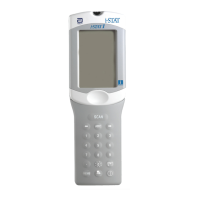Art: 714382-00D Rev. Date: 02/20/06 20-9
An important aspect of the Simulator is that it mimics the sensitive nature of
the sensor’s signals to ensure that adjacent input channels within the analyzer
or module maintain the required degree of electrical isolation from each other
to prevent “crosstalk” (see US Patent #5124661 for details). This cannot be
achieved by the traditional internal self-consistency checks characteristic of
modern microprocessor-controlled instrumentation.
Comparison of this regimen to laboratory quality control procedures can seem
confusing because it does not employ liquid control solutions. However,
the principle is the same in that the traditional intermittent quality control
measurements are applied to the persistent part of the system. In the case of
the i-STAT System, only the instrumentation is persistent so only this portion is
tested with an external challenge.
Further, use of an electronic quality control device has distinct quality
advantages:
1) Non laboratory-trained individuals do not need to interpret control
results because the analyzer and module software, expecting certain
simulator signals, automates the interpretation. In comparison,
many quality control regimens using liquid controls at the point of
care are ineffective because an out-of-control result is easy to ignore.
2) Injecting signals into the analyzer or module allows very tight
control limits to be set. Control limits using liquid controls at the
point of care are generally very wide to allow for sensor-to-sensor
variation.
The i-STAT Unit-
Use Cartridge as an
Element of Design
Robustness for Point-
of-Care Testing
The most important quality measure in the i-STAT System is that it is designed
to reliably deliver quality results in the hands of individuals not trained in
laboratory science. It addresses those aspects of the design in traditional
laboratory-based equipment and other point-of-care devices which detract from
robustness in the hands of these individuals.
1) In the interest of making batch processing efficient, laboratory
devices make extensive use of components which are exposed to
each test sample (sensors, tubing, etc.). These devices must be
continuously recalibrated as successive samples interact with these
elements. Quality control regimens are designed to detect incorrect
or required calibrations.
All elements which are exposed to the test sample are unit-use in
the i-STAT System. Many of the out-of-control conditions which a
laboratory quality control regimen is designed to catch simply do not
exist.
Furthermore, the use of unit-use devices is directly related to the
design of i-STAT’s quality approach. Each test begins with fresh
sensors and a fresh calibrant fluid. The response of the sensors’
signals to the fresh calibrant fluid is well characterized from a large
database of tests run in i-STAT’s manufacturing facility. If the sensor
signal is uncharacteristic due to mismanufacture, mishandling
or misstorage, the handheld analyzer or Blood Analysis Module’s
software will suppress the result (displays “***”).
2) Many point-of-care devices require the non laboratory-trained
user to interact directly with the sensing elements (paper strip
technologies for example). Many Point-of-Care Coordinators rely
heavily on the daily quality control regimen not only as a means for
monitoring system performance, but more significantly, as a means
for monitoring user proficiency.

